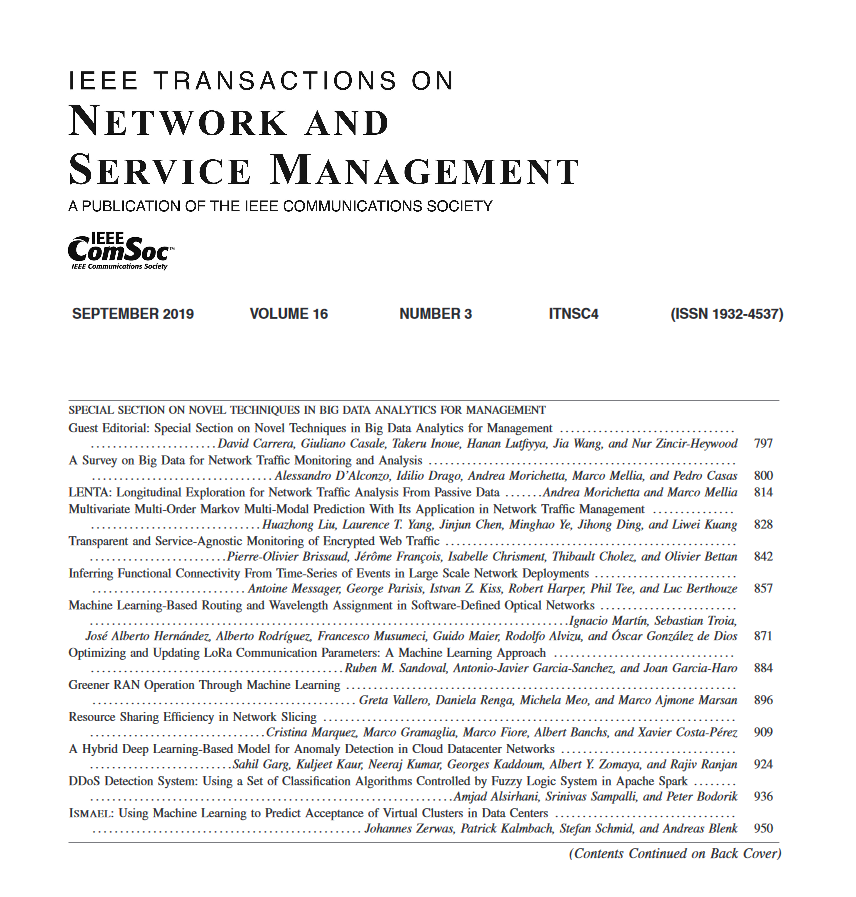Robust Deployment Model for Parallelized Service Function Chains Against Uncertain Traffic Arrival Rates
IF 5.4
2区 计算机科学
Q1 COMPUTER SCIENCE, INFORMATION SYSTEMS
IEEE Transactions on Network and Service Management
Pub Date : 2024-12-11
DOI:10.1109/TNSM.2024.3515078
引用次数: 0
Abstract
In network function virtualization, a network service is provided by a service function chain (SFC), which consists of a chain of virtual network functions (VNFs) within a specific order. SFC parallelism allows parallel processing among VNFs to reduce the end-to-end service delay. Existing works handle the service delay without considering traffic uncertainty, which leads to degraded performance on parallel structure balancing and deployment cost saving in the parallelized SFC deployment problem. This paper proposes a robust deployment model for parallelized SFCs against traffic uncertainty that satisfies the requirement of balanced parallel structures and minimizes the deployment cost. We define a traffic uncertainty set that handles both the variation of service traffic arrival rates and the fluctuation of parallel structures. We apply VNF sharing to improve the efficiency of resource allocation. We formulate the proposed model as a mixed integer second-order cone programming (MISOCP) problem. We introduce a heuristic algorithm to handle larger-size problems, where the MISOCP approach is intractable to obtain a solution in a practical time. Numerical results show the advantages of the proposed model in terms of deployment cost over the baseline models.不确定流量到达率下并行化业务功能链的鲁棒部署模型
在网络功能虚拟化中,网络服务通过业务功能链(SFC)提供,业务功能链是由一系列按一定顺序排列的虚拟网络功能链(VNFs)组成。SFC并行性允许在VNFs之间并行处理,以减少端到端服务延迟。现有工作在处理业务延迟时没有考虑流量的不确定性,导致并行SFC部署问题中并行结构均衡性能下降和部署成本节约。本文提出了一种鲁棒的并行sfc抗流量不确定性部署模型,该模型既满足并行结构平衡的要求,又使部署成本最小化。我们定义了一个处理业务流量到达率变化和并行结构波动的流量不确定性集。我们采用VNF共享来提高资源分配效率。我们将该模型表述为一个混合整数二阶锥规划(MISOCP)问题。我们引入了一种启发式算法来处理更大规模的问题,其中MISOCP方法难以在实际时间内获得解。数值结果表明,该模型在部署成本方面优于基线模型。
本文章由计算机程序翻译,如有差异,请以英文原文为准。
求助全文
约1分钟内获得全文
求助全文
来源期刊

IEEE Transactions on Network and Service Management
Computer Science-Computer Networks and Communications
CiteScore
9.30
自引率
15.10%
发文量
325
期刊介绍:
IEEE Transactions on Network and Service Management will publish (online only) peerreviewed archival quality papers that advance the state-of-the-art and practical applications of network and service management. Theoretical research contributions (presenting new concepts and techniques) and applied contributions (reporting on experiences and experiments with actual systems) will be encouraged. These transactions will focus on the key technical issues related to: Management Models, Architectures and Frameworks; Service Provisioning, Reliability and Quality Assurance; Management Functions; Enabling Technologies; Information and Communication Models; Policies; Applications and Case Studies; Emerging Technologies and Standards.
 求助内容:
求助内容: 应助结果提醒方式:
应助结果提醒方式:


